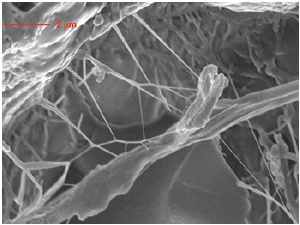Mar 26 2009
A new research discovery at Rensselaer Polytechnic Institute could lead to tougher, more durable composite frames for aircraft, watercraft, and automobiles.
 Researchers at Rensselaer have discovered a new technique for provoking unusual crazing behavior in epoxy composites. The crazing, which causes the composite to deform into a network of nanoscale pillar-like fibers that bridge together both sides of a crack and slow its growth, could lead to tougher, more durable components for aircraft and automobiles.
Researchers at Rensselaer have discovered a new technique for provoking unusual crazing behavior in epoxy composites. The crazing, which causes the composite to deform into a network of nanoscale pillar-like fibers that bridge together both sides of a crack and slow its growth, could lead to tougher, more durable components for aircraft and automobiles.
Epoxy composites are increasingly being incorporated into the design of new jets, planes, and other vehicles. Composite material frames are extremely lightweight, which lowers the overall weight of the vehicle and boosts fuel efficiency. The downside is that epoxy composites can be brittle, which is detrimental to its structural integrity.
Professor Nikhil Koratkar, of Rensselaer's Department of Mechanical, Aerospace, and Nuclear Engineering, has demonstrated that incorporating chemically treated carbon nanotubes into an epoxy composite can significantly improve the overall toughness, fatigue resistance, and durability of a composite frame.
When subjected to repetitive stress, a composite frame infused with treated nanotubes exhibited a five-fold reduction in crack growth rate as compared to a frame infused with untreated nanotubes, and a 20-fold reduction when compared to a composite frame made without nanotubes.
This newfound toughness and crack resistance is due to the treated nanotubes, which enhance the molecular mobility of the epoxy at the interface where the two materials touch. When stressed, this enhanced mobility enables the epoxy to craze - or result in the formation of a network of pillar-like fibers that bridge together both sides of the crack and slow its growth.
"This crazing behavior, and the bridging fibers it produces, dramatically slows the growth rate of a crack," Koratkar said. "In order for the crack to grow, those fibers have to first stretch, deform plastically, and then break. It takes a lot of energy to stretch and break those fibers, energy that would have otherwise gone toward enlarging the crack."
Results of the study were published this week in the journal Small.
Epoxy composites infused with carbon nanotubes are known to be more resistant to cracks than pure epoxy composites, as the nanotubes stitch, or bridge, the two sides of the crack together. Infusing an epoxy with carbon nanotubes that have been functionalized, or treated, with the chemical group amidoamine, however, results in a completely different bridging phenomenon.
At the interface of the functionalized nanotubes and the epoxy, the epoxy starts to craze, which is a highly unusual behavior for this particular type of composite, Koratkar said. The epoxy deforms, becomes more fluid, and creates connective fibers up to 10 microns in length and with a diameter between 100 nanometers and 1,000 nanometers.
"We didn't expect this at all. Crazing is common in certain types of thermoplastic polymers, but very unusual in the type of epoxy composite we used," Koratkar said. "In addition to improved fatigue resistance and toughness, the treated nanotubes also enhanced the stiffness, hardness, and strength of the epoxy composite, which is very important for structural applications."
Koratkar said the aircraft, boat, and automobile industries are increasingly looking to composites as a building material to make vehicle frames and components lighter. His research group plans to further investigate crazing behavior in epoxy composites, in order to better understand why the chemical treatment of nanotubes initiates crazing.
Co-authors of the paper include Rensselaer Associate Professor Catalin Picu, of the Department of Mechanical, Aerospace, and Nuclear Engineering; Rensselaer doctoral students Wei Zhang and Iti Srivastava; and Yue-Feng Zhu, professor in the Department of Mechanical Engineering at Tsinghua University in China.